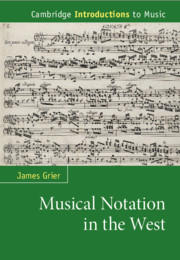Book contents
- Musical Notation in the West
- Musical Notation in the West
- Copyright page
- Dedication
- Contents
- Figures
- Tables
- Musical Examples
- Preface
- Chapter 1 Introduction: Musical Notation as a Symbolic Language
- Chapter 2 Plainsong and the Origins of Musical Notation in the West
- Interlude 1: The Problem with Pitch
- Chapter 3 Polyphony and Rhythmic Notation
- Interlude 2: Rhythm and Metre
- Chapter 4 The Transition to the Modern Era: Instrumental Music and Performing Indications
- Interlude 3: The Score
- Chapter 5 Notational Nuance in the Twentieth Century and the Motives for Notational Innovation
- Coda: The Meaning of Musical Literacy
- Bibliography
- Index
- Cambridge Introductions to Music
Chapter 4 - The Transition to the Modern Era: Instrumental Music and Performing Indications
Published online by Cambridge University Press: 28 January 2021
- Musical Notation in the West
- Musical Notation in the West
- Copyright page
- Dedication
- Contents
- Figures
- Tables
- Musical Examples
- Preface
- Chapter 1 Introduction: Musical Notation as a Symbolic Language
- Chapter 2 Plainsong and the Origins of Musical Notation in the West
- Interlude 1: The Problem with Pitch
- Chapter 3 Polyphony and Rhythmic Notation
- Interlude 2: Rhythm and Metre
- Chapter 4 The Transition to the Modern Era: Instrumental Music and Performing Indications
- Interlude 3: The Score
- Chapter 5 Notational Nuance in the Twentieth Century and the Motives for Notational Innovation
- Coda: The Meaning of Musical Literacy
- Bibliography
- Index
- Cambridge Introductions to Music
Summary
The earliest written instrumental music uses contemporary vocal notation: the dances in Pa 844 (thirteenth century), Lo 28550 (the Robertsbridge codex, fourteenth century), Lo 29987 and Faenza 117 (both fifteenth century). The Robertsbridge codex contains a hybrid notation in which the upper voice or voices appear in conventional vocal notation and the lower voice is represented by the letter names of the notes. This system becomes the ancestor of German keyboard tablatures of the fifteenth century, which similarly use conventional and literal notation for the upper and lower voices, respectively. These developments signal independent and idiosyncratic approaches to notation that become specific for each instrument or group of instruments, which we today collect under the generic term tablature.
- Type
- Chapter
- Information
- Musical Notation in the West , pp. 142 - 180Publisher: Cambridge University PressPrint publication year: 2021

